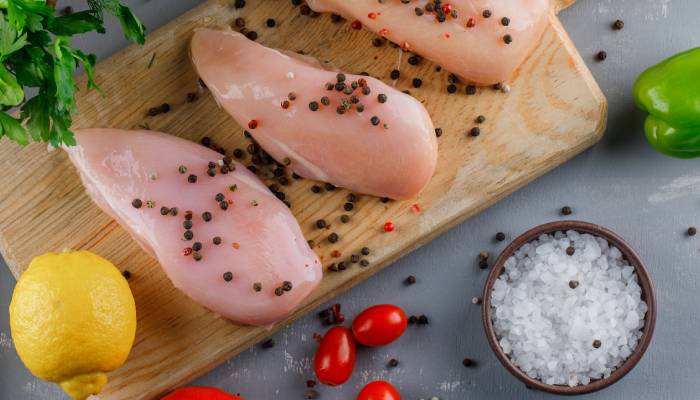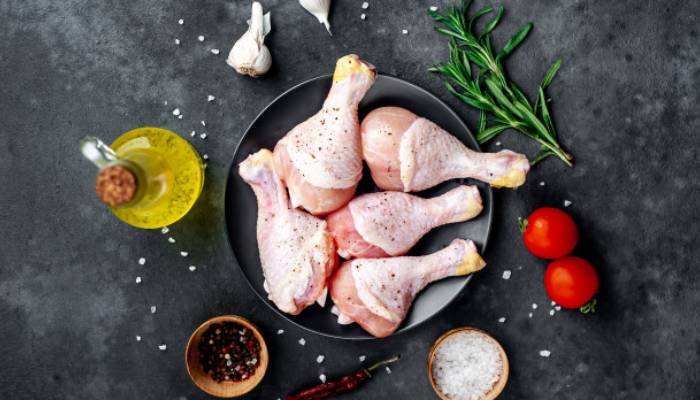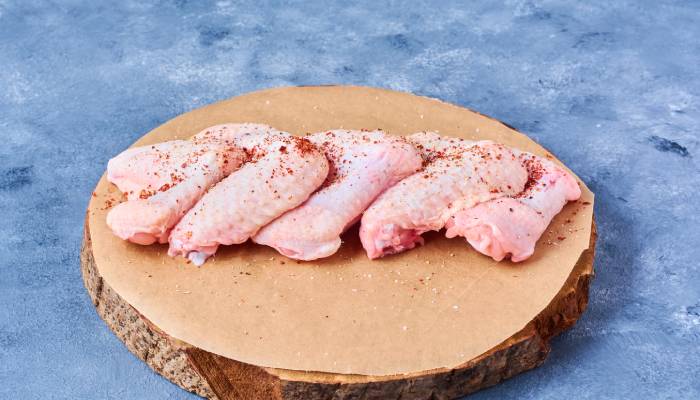Chicken, since it provides high protein with low calories and fat per serving, is one of the most common lean protein sources worldwide.
How many calories in a chicken
When it comes to lean protein, chicken is a common choice, as it packs a significant amount without a lot of fat in a single serving.
Plus, it’s easy to cook at home and in most restaurants available. It is easy to have chicken dishes on just about every menu, no matter what sort of food you enjoy.
But you might wonder just how many calories a chicken on your plate holds.
There are several cuts of chicken, including breasts, legs, wings, and drumsticks. A different number of calories and a different proportion of protein to fat are used with any cut.
Here are the calorie numbers for the most common chicken cuts.
Part of the charm of chicken is its versatility. A selection of chicken recipes is served by almost every cuisine from around the world. Chicken also has a relatively neutral taste, making it convenient to pair with various ingredients.
Chicken is available in several cuts, including:
- Breasts
- Thighs
- Drumsticks
- Wings
How many calories in chicken breast?

One of the most common cuts of chicken is chicken breast. It’s rich in protein and low in calories, making it a better alternative for individuals looking to lose weight.
The following nutrient breakdown occurs in one skinless, boneless, cooked chicken breast (172 grams)
- Calories: 284 Calories
- Protein: 53.4 grams
- Carbohydrates: 0 grams
- Fat: 6.2 grams of Fat
165 calories, 31 grams of protein, and 3.6 grams of fat are given by a 3.5-ounce (100-gram) serving chicken breast.
That means that about 80 percent of chicken breast calories come from protein and 20 percent from fat.
Bear in mind that these numbers of no extra ingredients apply to a simple chicken breast. You increase the overall calories, carbs, and fat until you start boiling it in oil or adding marinades or sauces.
Chicken Breast Nutrition Facts
For one 3-ounce (85g) serving of boneless, skinless grilled chicken breast, the following dietary information is given by the USDA. Note that individual commercially prepared chicken breasts are far more extensive than 3 ounces. So if you eat one breast, you’re expected to eat more than one serving.
Carbs
There is no sugar or starch in the chicken breasts (unless cooked with breading or seasonings) because they have no carbohydrates. The calculated chicken breast glycemic load is zero.
Fats
A minimal amount of fat, less than 3 grams, contains the skinless chicken breast. Most unsaturated fatwas (there is less than 1 gram of saturated fat in a 3-ounce portion of the skinless chicken breast).
The weight, calorie, and protein counts would all be higher if you keep the skin on your chicken breast. There are 165 calories, 6.6 grams of fat, and 25 grams of protein in a 3-ounce (85g) serving of fried, broiled, or baked chicken breast with skin.
Protein
A decent source of lean protein is chicken breasts. For people who consume beef, eating chicken is a convenient way to fulfill some of your body’s protein needs without eating a lot of fat. Chicken breasts are often naturally low in sodium, depending on the cooking process that you select.
Health benefits eating of chicken breast
There can be many significant benefits to the low-fat protein present in chicken breast, making this meal a beneficial addition to many eating strategies.
What’s the healthiest way to prepare breast chicken?
One of the main benefits of this powerhouse chicken is that it’s super flexible, meaning you can barbecue it, roast it, throw it over a green salad, shred it and bring it into tacos or wraps, or even skewer it and smother it in peanut sauce in a variety of different ways.
But of course, poaching, grilling, or baking chicken are the healthiest ways to prepare it; go for unsaturated plant-based oils (such as EVOO or avocado oil) when you grill or roast to minimize the addition of excessive saturated fats to your dish. And make sure to do so on low heat while you poach or boil it, so there is a limited loss of nutrients.
How many calories in chicken thighs?

Owing to the higher fat content, the chicken thigh is slightly juicier and tasty than chicken breast.
One cooked chicken thigh (52 grams), skinless, boneless, contains:
- Calories: 108 Calories
- 5 grams of Protein:
- Carbohydrates: 0 grams
- Fat: 5.7 grams Celsius
208 calories, 26 grams of protein, and 10.9 grams of fat are given by a 3.5-ounce (100-gram) chicken thigh serving.
Therefore, 53% of the calories come from protein, and 47% from fat.
Chicken thighs are always cheaper than chicken breasts, making them a decent budget alternative for everyone.
Health benefit of eating chicken thighs
The thigh of a chicken contains nutrients such as vitamins and minerals.
The most important minerals in the composition are copper, zinc, manganese, potassium, sodium, and phosphorus.
Group B, A, C, PP, E are the vitamins found in the thigh.
In addition, amino acids and protein, beta-carotene, choline are also present in the formulation.
The digestion and intestinal function of a human increase with the regular use of this form of meat for food, and metabolism accelerates.
Moreover, chicken thighs have a beneficial effect on the health of the bones.
Protein is processed by the body rapidly and provides the nutrition required to work normally. Moreover, protein allows muscles to build and expand.
The food also has a positive effect on the heart and blood vessels – blood pressure steadily normalizes as it is used in the daily diet.
For those with diabetes, consuming thighs may also be helpful, as they contain compounds that can reduce blood sugar levels. The difference in the health of the skin, hair, and nails as used is another positive property.
It should be remembered that the dish has no contraindications if you prepare such meat properly and strip the skin from it.
The nutritional value of chicken thighs
People especially those who wish to have a perfect physique, are most much interested in the calorie content of a specific product. It is incorrect to fail to consume meat for weight loss when the body requires valuable substances that it contains.
It is only enough to know how to cook a dish correctly so that the substance maintains its properties and that the meal is good and very fulfilling.
It is considered dietary only without the skin when it comes to the calorie content of fried meat, for example, chicken thigh. It has been demonstrated that there are just 160 calories in 100 grams of such a meal. So you can eat comfortably without fear of your weight, the main thing is to observe portioning of all.
100 g of skinless boiled chicken thigh contains
- calories – 160 kcal
- proteins – 21.2 g
- carbohydrates – 0.1 g
- fats – 10.7 g
Nutritionists prescribe consuming at least 4 meals a day in limited doses, thus avoiding all dangerous foods. There will be no concerns with being overweight, a persistent sense of starvation, and overeating as a result of this situation.
You can create any masterpiece in the form of a salad or a hot snack from chicken meat, namely the thighs when the skin is stripped and the food is served boiled.
It is worth putting a heavy emphasis on the fact that the adding of different seasonings and salt to meat is banned.
Chicken thighs for losing weight
This substance can be used in the diet for those who are gaining weight, just note that it has a higher calorie content than other food ingredients.
It is necessary not only to eliminate all the skin but also to remove the current layer of fat to further reduce the number of calories. You should also place the meat in cold water before frying – much of the remaining fat, thus, would go into the broth.
How many calories in chicken drumsticks

Two pieces are made up of chicken legs: the thigh and the drumstick. The lower part of the leg is the drumstick.
One drumstick of skinless, boneless chicken (44 grams) includes:
- Calories: 76
- Nutrition: 12.4 grams of protein
- Carbohydrates: 0 grams
- Fat: 2.5 grams
Chicken drumsticks have 172 calories, 28.3 grams of protein, and 5.7 grams of fat per 3.5 ounces (100 grams).
Around 70 percent comes from protein when it comes to calorie counting, while 30 percent comes from fat.
Are chicken drumsticks healthy?
The way you cook drumsticks for chicken has a big impact on how nutritious they are. Compared to roasted drumsticks, breaded and fried drumsticks contain slightly more fat and cholesterol.
Until swallowing it, cutting the skin off the drumstick further enhances the nutrient profile. An outstanding source of protein, essential amino acids, and other vitamins and minerals are chicken drumsticks.
Protein
47 percent of the DV of protein provides the same serving of chicken drumsticks. As protein is metabolized by the liver, it breaks it down into amino acids. Of the 21 amino acids your body requires to survive, 12 of them can be created by themselves.
The remaining nine have to come from food sources, known as essential amino acids. During the embryonic, childhood, and teenage stages, essential amino acids play crucial roles in cell formation and repair, metabolism, and proper growth and development.
Large quantities of five of the essential amino acids and lesser amounts of the remaining four are given by Chicken Drumsticks.
Cholesterol
45% of the DV contains cholesterol in a 105-gram serving of chicken drumsticks. Although your body requires cholesterol to produce cell membranes and some hormones, all the cholesterol you need is supplied by your liver.
Atherosclerosis, or hardening of the arteries, has been associated with high dietary cholesterol intake. 75% of cardiac-related deaths in the U.S. are associated with atherosclerosis and 80 to 90 percent of Americans above the age of 30 exhibit symptoms of the condition. Heart pain can also be caused by atherosclerosis and the risk for strokes increases.
Vitamins
A serving of roasted chicken drumsticks gives 40 percent of the daily dietary allowance for niacin for adult women and 35 percent of the RDA for adult males. Niacin allows the body to metabolize food to sustain healthy skin and nerve cells and a healthy appetite.
31 percent of adult RDA for vitamin B-6 is supplied by a serving. For the digestion and absorption of proteins and red blood production, vitamin B-6 is important.
It also encourages the body to make use of fat. 23 percent of the adult RDA for pantothenic acid is also given by a drumstick. In energy production and the development of some hormones, pantothenic acid helps.
Minerals
49 percent of the adult RDA for selenium contains just 105 grammes of roasted chicken drumsticks. Selenium is a dietary mineral that only requires limited quantities of selenium in your body, but also plays a significant role in your health.
It combines with protein to create sialoproteins, potent antioxidants, as the body metabolizes selenium. By restoring the cellular harm caused by free radicals, antioxidants help deter heart disease and cancer.
Selenium also plays a part in thyroid and immune processes that are healthy. 30 percent of the adult female RDA for zinc and 21 percent of the adult male RDA are also given by a roasted chicken drumstick.
For protein and DNA synthesis, immune function, wound healing, cell division, and your sense of taste and smell, zinc is important. It also helps foster the growth and development of the fetus, childhood, and adolescence.
How many calories in chicken wings?

Chicken wings definitely do not come to mind when you hear of nutritious cuts of chicken.
However, as long as they are not wrapped and deep-fried in breading or sauce, they can blend seamlessly into a healthier diet.
One (21 grams) skinless, boneless chicken wing contains:
- 6 Calories:
- Protein: 6.4 grams
- Carbohydrates: 0 grams
- Fat: 1.7 grams of Fat
Chicken wings contain 203 calories, 30.5 grammes of protein, and 8.1 grammes of fat for every 3.5 ounce (100 grammes).
This suggests that 64% of the calories come from protein and 36% from fat.
The health benefits of chicken wings
Chicken wings are a common food all over the globe. This is because in many respects they should be trained. For a healthy diet, which is available primarily in chicken meat, a human being requires animal proteins.
We may say with confidence that for the human body, this substance is one of the most useful.
- Recovers the body from falls, fractures, and treatments for surgery
- Helps to treat stress, neuritis, and neurological conditions
- Increases hemoglobin in the blood
- Participates in new cell formation
- Elevates the immunity level
- Improves skin, hair, and nail conditions
- Blocks free radical formation
- Prevents the creation of processes for cancer
- Reproductive function improves
- Brain activity normalizes
- Increases cartilage and connective tissue growth
- Regulates levels of blood glucose.
To fill the body with nutrients and vitamins, simply eat chicken wings 1-2 days a week. There’s ample meat in the chicken wing to make a soup or a full-course dinner.
Some other chicken cuts
While the most common cuts of chicken are breast, thighs, wings, and drumsticks, there are many others to choose from Chicken.
In some other chicken cuts (5, 6, 7, 8), here are the calories:
Tendering for Chicken: 263 calories per 3.5 ounces (100 grams)
Back: 137 per 3.5 ounces of calories (100 grams)
Dark meat: 125 per 3.5 ounces of calories (100 grams)
Light meat: 114 per 3.5 ounces of calories (100 grams)
Chicken skin calories contribute
Although a skinless chicken breast has 284 calories with 80% protein and 20% fat, if you add the skin, those figures change significantly.
One boneless, skin-cooked chicken breast (196 grams) requires:
- Calories:386
- Protein: 58.4 grams
- Fat: 15.2 grams
Fifty percent of the calories in a chicken breast with skin come from protein, and 50 percent from fat. In addition, almost 100 calories are added by consuming the skin.
Similarly, in addition to 42 calories in a skinless breast, one chicken wing with skin (34 grams) has 99 calories (21 grams). Thus in chicken wings with meat, 60% of the calories come from fat, compared to 36% in a wing without skin (3, 10).
So whether you’re looking at your weight or your fat consumption, to reduce calories and fat, feed your chicken without skin.
How the chicken matters cook?
In contrast to other foods, chicken meat alone is comparatively low in calories and fat. But the calories will add up until you start adding fat, sauce, batter, and breading.
For eg, there are 109 calories and 5.7 grams of fat in a skinless, boneless, cooked chicken thigh (52 grams).
But the same fried chicken thigh packs 144 calories and 8.6 grams of fat in the batter. There are more than 162 calories and 9.3 grammes of fat in a chicken thigh fried on a floor.
Likewise, there are 43 calories and 1.7 grammes of fat in one boneless, skinless chicken wing (21 grams).
Yet 61 calories and 3.7 grammes of fat are given by a chicken wing glazed in barbecue sauce. This is equivalent to a flour-coated fried wing that has 61 calories and 4.2 grams of fat.
Cooking strategies that incorporate low fat, such as poaching, roasting, grilling, and steaming, are also the best bet to keep the calorie count low.
Summary
Chicken is a common product, and although offering adequate-protein, most cuts are low in calories and fat.
The most popular cuts of boneless, skinless chicken per 3.5-ounce (100-gram) serving are the calorie counts here:
Breast chicken: 165 calories
The thigh of Chicken: 209 calories
Wing of Chicken: 203 Calories
Drumstick for Chicken: 172 calories
Remember that calories are added by chewing the skin or by using unhealthy cooking methods.
READ THIS NEXT
What is Alopecia areata: Types, Causes, Signs
Lower Back Pain: Can’t Stand Up Straight
How to Permanently Reduce your Appetite?
7 Most Common Stages of Hair Loss: Signs & Treatment
What Are The Best Way To Pop Your Ears

Comments are closed.